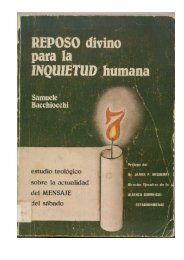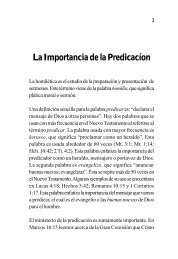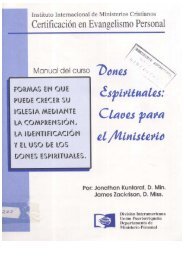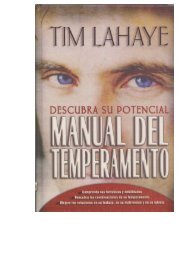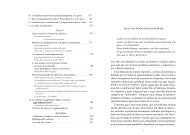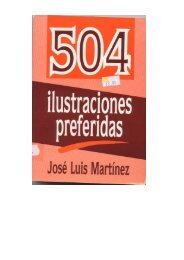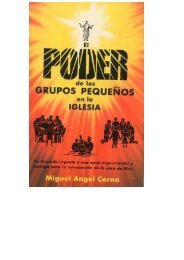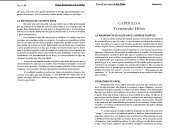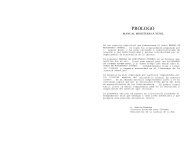Recapitulation in Revelation 4-11 - Ptr. Arturo Quintero
Recapitulation in Revelation 4-11 - Ptr. Arturo Quintero
Recapitulation in Revelation 4-11 - Ptr. Arturo Quintero
- No tags were found...
Create successful ePaper yourself
Turn your PDF publications into a flip-book with our unique Google optimized e-Paper software.
<strong>in</strong>terpretation of the silence which occurs when the seventh seal is opened. The question is whether thesilence is the climax of the series or whether it forms the <strong>in</strong>troduction to another series. 15If the seventh seal reaches up to Rev 8:5 or Rev 8:6, the seven trumpets seem to grow out of the sevenseals and are their extension. In the same way, the seven bowls may grow out of the seventh trumpet. In thiscase, there is not much room for recapitulation. If, on the other hand, the seven seals end with Rev 8:1, anew section starts with 8:2. In this case, one might opt for recapitulation.Some exegetes suggest a k<strong>in</strong>d of overlap between the end of the seven seals and the beg<strong>in</strong>n<strong>in</strong>g of theseven trumpets, us<strong>in</strong>g the device of “<strong>in</strong>terlock<strong>in</strong>g” or “<strong>in</strong>tercalation.” This means that the seals seriescomprises 4:1-8:5 or 4:1-8:6 and the trumpet series 8:2-<strong>11</strong>:19 or 8:3-<strong>11</strong>:19. 16Among other scholars who perceive Rev 8:1 as the end of the section, irrespective of the question ofwhether Rev 4-5 is an <strong>in</strong>troduction to the seals only or rather to a larger portion of <strong>Revelation</strong>, 17 areStrand, 18 Bowman, 19 and Holbrook. 20 Accord<strong>in</strong>g to their <strong>in</strong>terpretation, the septet beg<strong>in</strong>s with Rev 4 andends with 8:1.Start<strong>in</strong>g with Rev 8:7, the seven trumpets are described as the seals are <strong>in</strong> Rev 6. What about thesection 8:2-6? Indeed, many words are parallel between Rev 4:1-8:1 and Rev 8:2-6. 21 However, some ofthe words are not important for our purpose. They occur everywhere <strong>in</strong> <strong>Revelation</strong> and belong to thecommon stock of vocabulary <strong>in</strong> <strong>Revelation</strong>. They do not <strong>in</strong>dicate progression. Sometimes words are used<strong>in</strong> a different way and with a different mean<strong>in</strong>g <strong>in</strong> other places. 22 Some words come <strong>in</strong> clusters or formulas1980), 235; Krodel, 150-151; Coll<strong>in</strong>s, The Apocalypse, 55, supports this view, but she states that “this relationship should not beunderstood chronologically. . . The <strong>in</strong>terlock<strong>in</strong>g of the two cycles is a literary device.” See also ibid., 56. Rolf J. Pöhler, “Derliterarische Aufbau der Offenbarung des Johannes,” <strong>in</strong> Studien zur Offenbarung: Die Bedeutung der drei Engelsbotschaften -heute (Offenbarung 14,6-12) (Hamburg: Gr<strong>in</strong>deldruck, 1988), 1:69-71, suggests what he calls a telescope theory.15 See, for example, Richard Fredericks, “A Sequential Study of <strong>Revelation</strong> 1-14 Emphasiz<strong>in</strong>g the Judgment Motif: WithImplications for Seventh-day Adventist Apocalyptic Pedagogy” (Ph.D. dissertation, Andrews University, 1987), 185-87, whopo<strong>in</strong>ts to Hab 2:20, Zeph 1:7, Zech 2:13, and consequently understands the silence as a symbol of the “day of the Lord.” Seealso Jean-Pierre Charlier, Comprendre l’Apocalisse, 2 vols. (Paris: Les Éditions du Cerf, 1991), 1:194-195. Mathias Rissi, Wasist und was geschehen soll danach: Die Zeit- und Geschichtsauffassung der Offenbarung des Johannes (Zürich: Zw<strong>in</strong>gli Verlag,1965), 8-<strong>11</strong>, also connects the silence with the day of the Lord. It is a climax and not a transition to the next septenary. On theother hand, Henry Barclay Swete, The Apocalypse of St. John: The Greek Text with Introduction Notes and Indices (London:Macmillan, 1917),107, th<strong>in</strong>ks the OT texts are not relevant with regard to Rev 8:1. Jürgen Roloff, The <strong>Revelation</strong> of John: ACont<strong>in</strong>ental Commentary (M<strong>in</strong>neapolis: Fortress, 1993), 101-102, states: “In fact, the silence <strong>in</strong> heaven appears to be a referenceto the end-time work of God’s new creation.”16 See, for example, Coll<strong>in</strong>s, The Combat Myth, 16-19; and Leroy C. Sp<strong>in</strong>ks, “A Critical Exam<strong>in</strong>ation of J. W. Bowman’sProposed Structure of the <strong>Revelation</strong>,” Evangelical Quarterly 50 (1978): 216.17 See, for example, Cors<strong>in</strong>i, <strong>11</strong>8, 161; Michel Gourgues, “‘L’ Apocalypse’ ou ‘Les trois apocalypses’ de Jean?” Scienceet Esprit 35 (1983): 304-3<strong>11</strong>; Rissi, 8-<strong>11</strong>; Ernst R. Wendland, “7 X 7 (X 7): A Structural and Thematic Outl<strong>in</strong>e of John’sApocalypse,” Occasional Papers <strong>in</strong> Translation and Textl<strong>in</strong>guistics: OPTAT 4 (1990): 376-78; Vester Eugene Wolber, “AStudy of the Literary Structure of <strong>Revelation</strong> as an Aid to Interpretation” (Th.D. dissertation, Southwestern Baptist TheologicalSem<strong>in</strong>ary, 1950), 36, 39, 42, 61; and Theodor Zahn, Die Offenbarung des Johannes, repr<strong>in</strong>t (Wuppertal: R. Brockhaus Verlag,1986), 364.18 Strand, Interpret<strong>in</strong>g the Book of <strong>Revelation</strong>, 48; idem, “The Eight Basic Visions,” <strong>11</strong>2.19 John Wick Bowman, “The <strong>Revelation</strong> to John: Its Dramatic Structure and Message.” Interpretation 9 (1955): 441.20 Frank B. Holbrook, “Issues <strong>in</strong> the Book of <strong>Revelation</strong>,” M<strong>in</strong>istry, January 1991, 10-<strong>11</strong>, summariz<strong>in</strong>g a committeestatement, declares that Rev 4:1-8:1 belongs to the historical section of <strong>Revelation</strong>. Rev 8:2-6 forms the <strong>in</strong>troduction to thesequence of the trumpets <strong>in</strong> the form of an <strong>in</strong>clusion.21 In each case just one reference per section is given: I saw (6:1; 8:2), seven (6:1; 8:2), angels (7:1; 8:2), God (6:9; 8:2),stood (7:<strong>11</strong>; 8:2) trumpets (4:1; 8:2), another angel (7:2; 8:3), came (6:17; 8:3), altar (6:9, 8:3), hav<strong>in</strong>g (6:2; 8:3), golden (4:4;8;3), it was given him (6:2; 8:3) <strong>in</strong>cense (5:8; 8:3), prayers of the sa<strong>in</strong>ts (5:8; 8:3), every/all (6:15; 8:3), before the throne (4:5;8:3), hand (6:5; 8:4), took (5:7; 8:5), time (4:5; 8:5), cast (4:10, 8:5), earth (6:4; 8:5), was/were (6:12; 8:5), thunder and voicesand flashes of lightn<strong>in</strong>g (4:5; 8:5), and earthquake (6:12; 8:5).22 For example, the golden altar <strong>in</strong> Rev 8:3 is not necessarily identical with the altar <strong>in</strong> Rev. 6:9.Page 4




